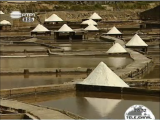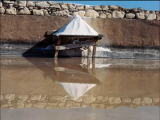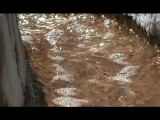Salinas de Rio Maior
Location
The municipality of Rio Maior is located in a transition area where the influences of Ribatejo and Estremadura are mixed, creating an original space.
Administratively it is part of the Santarém district and is integrated in the Tourism of Lisboa and Vale do Tejo.
Rio Maior is situated in the centre of Portugal, 75 km away from Lisbon, 30 km from Santarém and 20 km from Caldas da Rainha, with good access to both North and south.
The North region is part of the Natural Park of Serras d´Aire e Candeeiros where the salt-pans are included.
The salt-pans can be found 3 km away from Rio Maior, in a valley at the bottom of Candeeiros Mountain. Surrounded by trees, vineyards and other cultivated lands are considered a natural wonder, once the sea is about 30 km.
The whole presents like a tiny village with streets of stone and wooden houses, where some curious tanks of irregular sizes and shapes can be found. In spring these tanks are full with salt water giving origin to white pyramids of salt.
History and Production
The oldest document referring to the Salinas dates back to 1177, but it is believed that salt was already explored in Pre-historic times.
Candeeiros is a limestone mountain region with many fissures in the rock, which enables the rain water to penetrate forming undercurrents.
One of these undercurrents passes across a very extensive and deep rock-salt mine and feeds the well in the centre of the pans. This water is seven times saltier then the sea water.
This rock-salt occupies the region of the Portuguese Estremadura, between Leiria and Torres Vedras (about 100 km). It was formed millions of years ago.
In old times the water was taken, day and night, by the means of two buckets, attached to two wooden rods. That was then the most hard work of salt extraction. Nowadays the salt water is taken from the well by means of a motor-pump which takes it to the “concentrators”. These are eight tanks with a capacity for a million litres through which the water passes and evaporates. This is a recent process.
The water, already concentrated, goes back to a distribution basin, which stands by the well, and there continues to the pans.
The well from where the water is extracted, is common property. The right to the water depends upon the proximity to the well according to rules whose origins are lost in time.
Once the water is inside the pans the evaporating process takes about three to six days, depending on the heat. This means that each pan produces salt weekly.
The salt is put together with iron shovels (once wooden) and put to dry on a threshing floor (Eira) for sixty hours. Afterwards it is taken on a wheel-barrow or in sacks to the machine (dumper) which takes it to the cooperative wooden houses or to the wooden houses of the private workers.
The salt is grinded, or not, according to the industry it is meant for. Not taking any chemical treatment it’s purity comes from the Sun and the wind and the work of the sailor.
In a recent past most of the salt producers were farmers, who dedicate to this activity from June to September. The profits are divided fifty-fifty between the owner of the pan and the Sailor (salt workers). Nowadays a team of workers are contracted by the cooperative society to make the exploration of the salt-pans.
They are a living museum where throughout the 8 centuries of history the methods of exploring the salt have little changed, which gives the place its peculiar character. However, the demand for an ever growing industry leads to a constant progress and innovation on the techniques used by the workers.
The challenge is to adapt to a competitive economy and simultaneously preserve this unique patrimony.
In 1979 the Cooperative Society of the Salt Producers of Rio Maior was created to improve productivity and marketing of the salt. This purely biological salt is exported to Germany because of its high quality and the absence of any additives or chemical treatments.
Fleur de Sel
Fleur de sel - "Flower of salt" is a hand-harvested salt collected by workers who scrape only the top layer of salt before it sinks to the bottom of salt pans. Due to its quality and relative scarcity, Fleur de sel is one of the more expensive salts.
Salt cheeses
The salt is given the shape of a cheese and it is heated to dry in an oven.
They can be kept as souvenirs or used to season the food.
Wooden houses
Wooden houses were used to store the salt. They are currently being used for commerce once the salt is now stored in the cooperative facilities. Wood was chosen to avoid corrosion.
The exterior side supports are olive tree logs.
Wooden lockers and keys
The key is the smaller piece. It is pressed up releasing the bolt.
There are no two keys alike.
Wooden Rulers
These rulers were used to write down the expense done by each worker in the tavern which was established in a wooden house during the season. They were about 150 cm long and 15 cm large.
Conventional symbols were used, each representing a drink and its price. Payments were made with salt. Some rulers can still be seen hung on the wall at the café.
Out of curiosity
|
Number of pans
|
470
|
|---|---|
|
Area of the pans
|
35 to 50 m2
|
|
Total area
|
27.000 m2
|
|
Well
|
8,95 m deep
|
|
|
3,75 m diameter
|
|
1 Litro de Água
|
220 g salt
|
|
Annual production
|
2.000 tons
|



